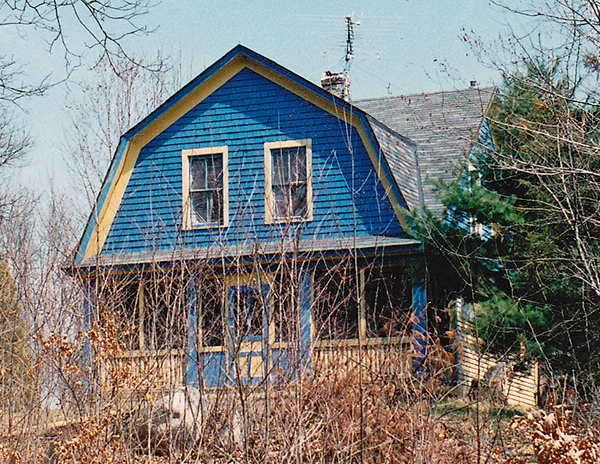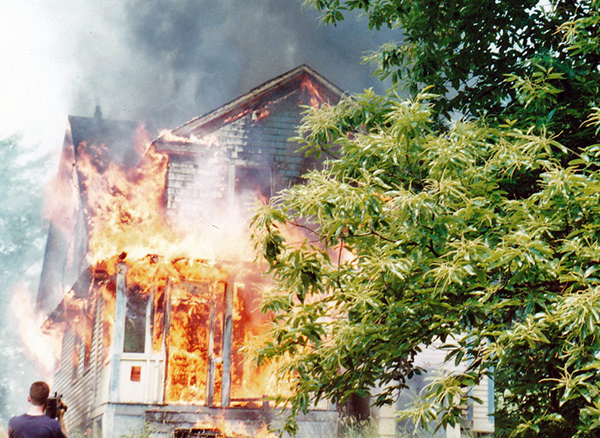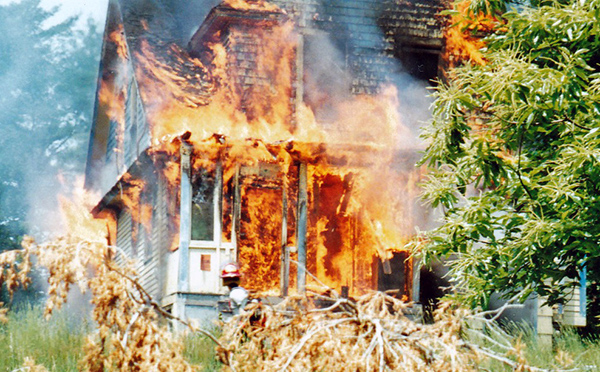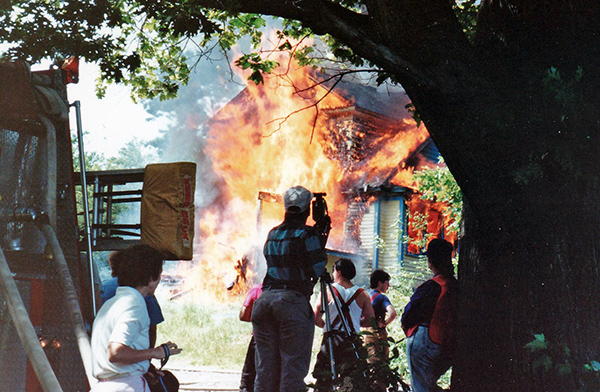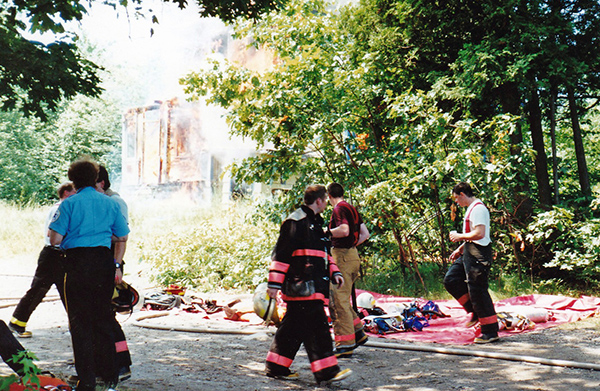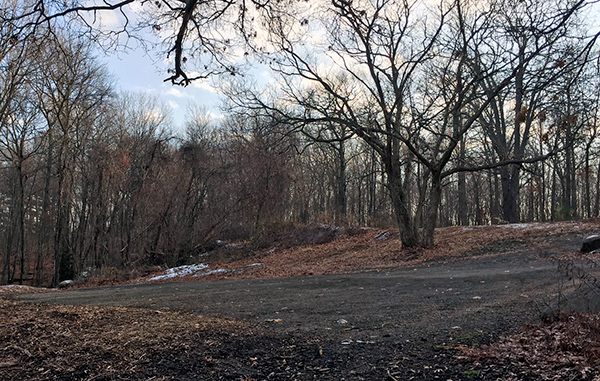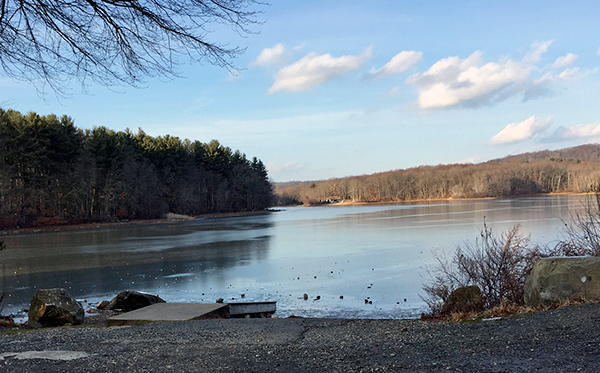|
|
||||||||||||
 |
 |
|
Wolcott Historical Society News - January 2017 By Florence Goodman Happy New Year, history keeps marching on; 2016 was a great year for donations to the Historical Society's museum. I have truly enjoyed writing about some of them and can only hope that residents will continue to share their family history with us. With that stated, this article will explain four pictures that were recently given to the Society from Josephine Houghtaling who grew up on Diamond Terrace. Josephine took these photographs in June of 1992, which depict the Wolcott Volunteer Fire Department burning a house located at the end of Scovill Road. Many hikers along Mill Pond Way walk past this spot without ever knowing what this site held eighty years ago. Previously in 2009 and 2013, I shared the history of the building of the dam, but this month I would like to revisit parts of those articles and focus on the Hart house on Scovill Road.
The Mad River Water Company began construction on the reservoir and dam in 1917. The reservoir covered approximately 330 acres of land and its water was used by the Scovill Manufacturing Company to produce brass. The lower dam was referred to as the Cornelis Dam and was made of masonry and earth. This sixty foot long dam consisted of double spillways; one arched and the other straight. Originally both spillways were arched. Construction of the upper dam caused the Mad River to flood the land and form the Woodtick Reservoir. The water in the reservoir covered sections of two old roads; the present Scovill Road was originally part of Fairclough Road, which ran straight through to the intersection of Munson and Coe Roads. The road where the Kiwanis Club Day Camp is located today was the other section of Fairclough Road. About one thousand feet of Fairclough Road was covered by water with the creation of the dam. Wolf Hill Road, which runs along the west side of the reservoir, was built to replace Fairclough Road. The lower end of Bound Line Road, just below Coe Road to the intersection of Woodtick Road replaced the older section of Bound Line Road that was also flooded by the new dam. Farm properties that belonged to Conrad Herbst, N. Hanson and D.L. Frisbie were lost to the flooding of the land, as well as, the Timothy Root House that was on Fairclough Road.
Mr. Joseph Winkler was nine years old when the dam was under construction; he gave the following account of the dam's construction. "There were barracks where the Kiwanis Club Camp is that housed about 300 men and a store where the workmen charged their purchases to their accounts and when they got paid, they discounted what they owed the store. Everything was done with dumpcarts not trucks. Everything was operated by steam: the water pumps, the steam shovel, the derrick, and the cable car, as it was called, which dumped the cement out. When they built the earth dam at the end of Scovill Road, they brought all the dirt in. They built a cement core and then put earth on both sides of it. The piece of Woodtick Road (near Bound Line Road) was raised up about five feet so it wouldn't be flooded and they moved part of Bound Line Road. Up by Dingwell's Bike Shop and Cocoa"s Garage, they had a stone crusher that made three grades of rock, that they used in the cement. On Wolf Hill Road, they had a place dug out in the rock, where they blasted out the rock and used another stone crusher. They had a cement mixer operated by steam and one operated by gasoline. That dam goes as deep into the ground, practically as far as it goes above ground. They had one truck, a "Kissle Kar" that brought the cement from the railroad station in Waterbury. There were two 12' X 12' towers built of Georgia pine, one at Wolf Hill Road and one at the end of Scovill Road. They had a series of cables that they would use to bring the cement bucket out on, to wherever they wanted to dump it."
Although the construction of the reservoir/dam changed the path of the Mad River and the physical characteristics of the land around it forever, today we are able to walk this land and only imagine what it was like 100 years ago. The farms, roads, pasture lands and stonewall boundaries were lost to these floodwaters; even the original site of the Wolcott Fair Grounds, located on Munson Road between the river and the road close to the intersection of Brooks Hill Road is gone, but not forgotten.
In 1936, Mr. Leslie Hart who was employed at Scovill Manufacturing became the caretaker of the upper reservoir and boat dock area. He and his wife, Loretta and children lived in the company owned house located at the end of Scovill Road. There was also a large barn on the property with a top level that was perfect for holding parties, which they did quite often. Hart stated in an article from the Waterbury Republican that, "members of Scovill Rod and Gun Club could buy a fishing permit for fifty cents." He received ten percent commission for the permits and boat rentals. When he was at work, his wife had the job. Hart was also responsible for the upkeep of the wooden boats that were rented out. Each fall you could see him scraping and repainting them for spring when a fishing contest was held for Scovill employees. Mr. Hart would weigh the fish as they were brought in; the fisherman who caught the largest fish would receive a nice prize. There were trout, large and small-mouthed bass, bullhead and pickerel in the reservoir for the catching. Mr. Hart was also responsible for opening and closing the floodgates on the dam. He said that during World War II, Scovill was making ammunition and they used the water from the reservoir at the factory. The local police were stationed at the dam twenty-four hours a day to guard the huge cement dam and make sure it wasn't bombed. Hart and his family lived in the house and maintained the property at the end of Scovill Road for over fifty years.
In April of 1985, the Scovill Manufacturing Company made an offer to Mayor Edward Wilensky for the town to purchase Woodtick and Chestnut Hill Reservoirs and Cedar and Hitchcock Lakes for a total of $3,269,000. After negotiations with Scovill, the Town held a referendum on June 11, 1986, to approve a $1.4 million bond issue to buy Woodtick Reservoir. It was approved by a 965-85 vote. The final price of the package included $740,000 for the Woodtick Reservoir, $460,000 for dam repairs, required by the State DEP, and $200,000 for engineering and legal fees, and a contingency fund. As part of the purchase, which was signed on July 9, 1986, the Town was given Hitchcock Lake and Chestnut Hill Reservoir, both for "no consideration".
Sometime in 1990 the Scovill Recreation Area was renamed the Woodtick Recreation Area. Today this attractive recreation area is enjoyed by town residents as well as residents from surrounding towns. After the town took over the property, the Hart house at the end of Scovill Road was no longer used; so in June 1992, it was raised by the fire department. The pictures that Josephine Houghtaling donated captured this event. I have also included a picture of the house before it was destroyed.
(Information for this article was taken from Samuel Orcutt's The History of the Town of Wolcott, Connecticut From 1731 to 1874, The Woodtick Dam and Reservoir by Skye MacBroom, The 1986 Historic Resources Inventory by J.P.Loether, and Wolcott, Connecticut 175th Anniversary 1796-1971 by John Washburne and a 2013 phone conversation with Mary Hart, daughter-in-law to Leslie Hart)
The Hart house was located at 21 Scovill Road in 1990.
The burning of the Hart house in June of 1992.
Another picture of the burning of the Hart house in June of 1992.
Filming of the burning of the house.
Volunteer Fire Department and Paramedics at the burn site.
A 2016 picture of the land where the house was located.
A view of the reservoir and boat ramp at the end of Scovill Road. The Hart house would have been behind this view.
To view past installments of the Wolcott Historical Society News, click here.
|
|
|
[Home]
[News]
[Purpose]
[Calendar]
[Museum]
[Membership]
[History]
[Contacts]
[Links]
All material at Wolcott Historical Society Web sites Copyright © 2000-2017 Wolcott Historical Society |
